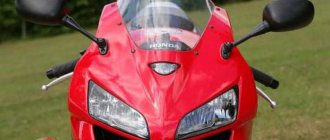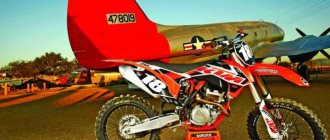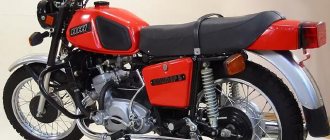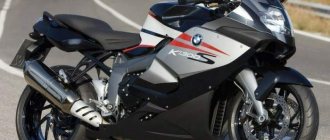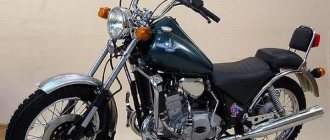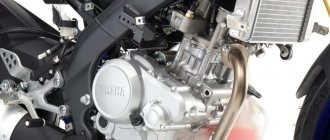Technical characteristics of the Honda cbr 600 f4i motorcycle
| Engine volume, cm3 | 599 |
| Power, hp | 110 |
| Number of cylinders | 4 |
| Number of cycles | 4 |
| Maximum speed, km/h | 260 |
| Gasoline consumption, l | 6,4 |
| Tank volume, l | 18 |
| Transmission | 6-speed |
| Dimensions, mm | 685/1135/2041 |
The four-cylinder engine is liquid cooled. Each cylinder has four valves. The motor runs without sudden movements. The revs pick up smoothly. When you reach more than 7000 rpm and switch to sport mode, jerks are not observed. The engine is started using an electric starter. The ignition system is completely electronic. The motorcycle has a three-phase generator.
The gearbox, in general, is not very different from Honda sports models. The gears switch on clearly. The box is reliable in operation.
The front suspension consists of a telescopic fork with a travel of 120 mm, and the rear suspension is a pendulum fork with a travel of 120 mm. The suspension is adjustable to suit your driving style and road conditions. Brake system: hydraulic disc. The front brake consists of two discs, and the rear one - of one.
I once said the same thing: “Hondas don’t break.” But I'll start from the beginning. I bought my Ike in June 2013. The mileage on the dashboard was 29,000, although it’s hard to believe such mileage on a 10-year-old motorcycle. Over the course of a season and a half in Moscow and the surrounding area, as well as several short long-distance trips, I drove another 31,000. During this time, the motorcycle didn’t particularly bother me, I didn’t even change the consumables much. I serviced it completely immediately after purchase, and then only the oil and filters. The tires and chain had to be changed closer to the 30 thousand mark. Although there were some unpleasant moments.
But the bike began to literally crumble towards the end of last season. And I opened this season only yesterday - June 3rd. I’ll tell you about what happened and how much it took to restore it.
Problems.
It all started with the voltage regulator relay. The motorcycle, after a long trip through traffic jams, when the speed was spinning almost at idle for half an hour, stopped starting. When I pressed the ignition button, the device went out and went to reboot. The starter didn't even think about turning. At first I was scared, thinking the worst. I started checking the terminals and fuses. In the end, I didn’t find anything suspicious, people helped, they started me up with a pusher, I walked along the already empty Moscow Ring Road, the battery was recharged and didn’t bother me for a week. I decided that maybe the terminal had come loose or something. However, during another long traffic jam, my turn signals first stopped working, and when I clicked on the high beams, the tidy went out. The engine was running. I stopped at a gas station, checked the terminals, fuses, wires, then ran around with the motorcycle for about 15 minutes, finally started it and didn’t turn it off all the way to the garage. I didn't have a battery charger. I consulted with different people both in person and online. For some reason, everyone said that the problem was 100% in the battery, but they didn’t even mention the relay - like the charge is coming, that means it’s working. As a result, I bought a new battery, installed it, everything naturally became fine, and I rode for almost 2 more weeks and was happy. But since, in fact, my relay was still dying, which was no longer providing sufficient charge, the battery slowly discharged. Buying relays in stock in Moscow was also a story, and they then cost 4-5 thousand. During the time it took me to find it, I became an ace in starting a motorcycle from a pushrod - a couple of meters of run was enough.
But, as they say, trouble does not come alone. As soon as I changed the relay, the next day, when accelerating in second gear around 7-8 thousand rpm, my speed suddenly jumped to the cutoff for half a second, and the acceleration at that time, on the contrary, disappeared. Then I drove on normally. Then I tested it all day - everything worked perfectly. What it was, I didn’t understand then. A few days later it happened again. Then it began to appear 3-4 times a day. After a week, this happened with every acceleration. Since this happened only in second gear and precisely during intense acceleration, there could be no doubt that my zizer was in the box. But it was already autumn, depending on the weather, there was a month or a month and a half left until the end of the season, and no one would make a box in a week. I decided to finish the ride like this and do it in the winter. After some time, the jumps in revolutions stopped - the transmission simply began to fly into neutral. And after a couple of days, crashes occurred even without intense acceleration - just at rpm above 4000. As a result, I didn’t even engage second gear: clutch, two clicks up and off we went. True, in traffic jams, because of this, I had to turn the first gear, because the motorcycle would not move in third.
At the very end of the season, at the end of October, when white flies began to fly, another strange thing appeared. In first gear, at steady revs, the motorcycle twitched barely noticeably. It was so imperceptible that the second number did not feel anything at all. I couldn't understand the reason. I thought it might also be a problem with the gearbox, because I didn’t notice this in other gears. But since there was nothing left to ride, I didn’t do anything anymore. I decided that in winter we’ll check it at the service center in one go.
Repair.
For the first 3 months the motorcycle spent the winter in a warm box. In February, it was finally sent to service. There they carried out a more or less complete diagnosis. It turned out that there was 0 compression in one cylinder... They opened the head, and there...
At first there was talk of replacing half the engine, including even the pistons. It was cheaper to either buy a whole contract engine or sell the motorcycle for parts and buy a new one. But we looked further and thought that we shouldn’t change it. The price was comparable to a used engine, but with a guarantee of normal operation. Because it is not known how long another used engine will be destroyed and what will have to be repaired in it.
In the end, we agreed on rings, valve stem seals, liners, gaskets and a bunch of other little things like washers, rings, etc. Plus, about 70% of the box was replaced: 5 gears, forks, a copy shaft and all sorts of washers, bearings, etc. The result was 63 positions. The service had to clean everything from carbon deposits, grind the valves, assemble and set everything up. I looked for and ordered spare parts myself, since directly through large stores it cost 125 thousand with delivery (at that time the dollar had just crossed the threshold of 100 rubles and cost about 70). It took a month to find people who could buy it cheaper. Moreover, different spare parts cost different things for everyone. For example, one fork cost 2500, another 4000, and in the store 3500 (all prices include delivery). But this other one had some inserts that were 2 times cheaper than the others.
The tale is told quickly, but the deed is not done quickly. It took another month to deliver everything. The last spare part was received around April 20th. Next came the assembly, in which I did not participate, but simply waited for the result.
Now for the prices: Almost 75,000 were spent on all spare parts. Which is clearly better than the original 125k. Plus consumables (oil, filters, coolant, spark plugs, brake fluid, pads front/rear, tapered bearings for the steering wheel) - 16,000. Plus work - 44,000. Total 135,000 rubles.
I bought the motorcycle for 220...
By the way, I even thought about selling it at the end of the season and buying something newer. But with the box destroyed, I didn’t want to sell it for just 150k. And now we can assume that I have a 12-year-old motorcycle worth 300 thousand. But at least you can ride for another season or two =)
Honda doesn't break, they said...
Flaws:
- The timing chain tensioner can ring in the range of 2000-5000 rpm, but this does not affect the chain in any way.
- At high speeds, you have to practically lie down on the tank, which leads to some discomfort in the back when driving for a long time in this position.
- Weak head light. Eliminated by replacing conventional lamps with xenon ones.
There are certain difficulties in which class the Honda cbr 600 f4i sport belongs to. On the one hand, the characteristics of a sports tourist can be traced, and, on the other hand, the characteristics of the engine and gearbox correspond specifically to a sportbike. In terms of ergonomic and aerodynamic characteristics, this is more of a sport-tourist. But, in terms of its behavior, it is a pure city sportbike.
Motorcycle suspension and possible problems with it
No matter how good and reliable the Sibierka is, the pendant, like a cat, has only a few lives. Under harsh operating conditions, even it begins to act up and show its character. This is especially true for the loaded rear wheels and suspension on almost every sportbike. During inspection, due attention should be paid to the wheel bearings, rear sprocket and steering column, especially if there is a suspicion that the former owner liked to roll in a sharp style along with wheelies, stoppies and other acrobatic sketches.
Replacing these elements will easily fit into the standard price list of a middle-class motorcycle service. In fact, you can do everything yourself if your hands grow from the right place and you have a manual at hand.
Second generation (2003-2006)
The manufacturer started thinking about the first modification of the Honda CB 600 Hornet after 2000. Then the main emphasis was on lengthening the base and redesigning the front fork to accommodate 17-inch wheels. A little later, the Honda cb 600 line was supplemented with an S version with a front fairing. True, in 2003 its production was discontinued due to the release of the second generation of the theme hero. The new Hornet differed from its predecessor in its fresh design, improved instrument panel, upside-down fork, immobilizer, universal brake pads from Nissin, as well as a larger 17-liter gas tank.
In parallel with the Honda cb 600, the range of the Japanese manufacturer was supplemented by the Honda SBF 600, which was intended to push aside the model with the “500th” engine. In particular, we are talking about the Honda cbf 500.
Photos and videos
What else you can read:
- It's time to buy a Volkwagen Transporter T4
- In the top 5 – Chevrolet Cruze hatchback
- Consequences and solution to the problem of engine water hammer
- BMW 3 Series 2022 – Taking your breath away
- Renault Megane 4th generation will become a sedan in 2022
- BMW X7 2022 – The oldest brother
- The new Toyota Avensis 2022 is back!
- Renault Logan: replacing the timing belt – Video tutorial
The effectiveness of this technique
But all this is more than compensated for by a successful combination of design, handling, ergonomics and safety for an affordable price of $7,899. Those who are forced to make trips of more than 300 km in one direction will appreciate the ease of landing, smooth ride, pleasant “buzz” of the 4-cylinder 16-valve engine and the precise operation of the six-speed gearbox. By the way, many consider second gear in this unit to be superfluous.
The CBR 600 F4/4i is as enjoyable to ride at low speeds as it is at high speeds. By high speeds we mean speeds of 250-260 km/h (some motorcycle owners talk about deliberately fibbing the speedometer as an alternative to the limiter, due to the “civilian” orientation of this bike. But be that as it may, even with the factory settings of the shock absorbers intact, there are bumps and Uneven road surfaces are “swallowed” quite quickly.
An undoubted advantage in operating this Honda “six hundred” is its budget in terms of consumables and spare parts: the moderate heat of the engine does not “eat up” oil and does not wear out tires as intensively as happens with namesakes with liter engines, and brake pads even more so “ live" much longer. Well, it’s not worth talking about the availability of various components.
In general, the unit is very good. Ardent fans and envious competitors even agreed that the bike is so perfect that it is sometimes boring.
Tuning and expenses
Honda CBR600 F4i is a real stadium for lovers of upgrades and tuning. Today in European and American catalogs you can find a bunch of different “gadgets” for this motorcycle, which can affect the speed, and also do not touch this option in any way. From creative plastics to everyone's favorite stand that's a must-have for long-distance travel. There is also a large selection of direct-flow mufflers and zero filters. There is, however, one point - experienced professionals advise installing Power Commander along with the “easy breathing” system. The fact is that the changed pressure at the inlet and outlet significantly worsens the operation of the engine with standard brains.
60-tooth driven sprockets, cross handlebars with brackets, as well as auxiliary brake calipers, cage bars and yokes - all this can be found in almost every street catalog that respects itself and its clients.
The range of tourist body kits is also extensive. Gel saddles and pannier systems, touring glasses and much more that a truck driver needs.
What remains to be added? The only thing is that a motorcycle of this class is, perhaps, one of the best options that is suitable for almost everyone who wants to ride on two wheels.
Characteristic features of the unit
The aerodynamic characteristics of this model are pragmatic - oncoming air flows are not just dispersed, they are absorbed by the front air intakes, which significantly improves the responsiveness of the carburetor throttle. And the combined, aggressively smooth relief of all fairings creates a certain futuristic appearance of the motorcycle and the “rider” sitting on it. And even the passenger in the back does not spoil the picture at all - he has the same landing position as the pilot. Everything looks very organic and seamless.
Anyone who has an obvious or hidden love for bikes, riding the CBR f4i, will not miss the opportunity to bring the tachometer needle to 10,000 rpm. And only then will he think about the possible need to brake sharply. But this is all right: 4-piston brakes, double-disc in front and single-disc in rear, are many times more sensitive and at the same time more effective than their predecessors.
Not without criticism, of course... Particularly picky “users” express dissatisfaction with the lack of rear visibility. This refers to the rear view mirrors. Although, it’s true, they could be spaced horizontally a little more, increasing the length of the mirror holders by at least a centimeter each. The convex protective covering of the speedometer and tachometer also causes criticism - in bright sunshine, the readings of these instruments are almost invisible due to glare. The same applies to the LCD daily mileage counter, which without a mirror backing - in daylight - its readings are not visible. But even more discomfort when driving is caused by the absence of a fuel level indicator (there is only a reserve capacity sensor). Despite the general focus of such equipment on convenience and comfort, the underseat luggage rack is very small, which does not allow you to carry something bulky with you.
Dimensions and weight
The dry weight of the car is 170 kg, while the fuel tank volume is 18 liters. Taking into account the average consumption of 6 liters per hundred, the gas tank capacity should be absolutely sufficient. In terms of dimensions, the car occupies an average position in the class.
For whom
Here are the main features of the model:
- distinctive sporty design;
- comfortable ride that does not strain your back;
- good performance in terms of power and torque.
This model, strictly speaking, is not quite a sports bike, unlike previous versions. However, such a machine is in no way suitable for a beginner, because only a professional can handle it.
